Video Lecture
Theory For Making Notes
Lorem ipsum dolor sit amet, consectetur adipiscing elit. Ut elit tellus, luctus nec ullamcorper mattis, pulvinar dapibus leo.
Practice Questions (Level-1)
Q.1
An L–C–R series circuit is connected to a source of alternating current. At resonance the applied voltage and current flowing through the circuit will have a phase difference of
(a) zero (b) π / 4 (c) π / 2 (d) π
Ans. (a)
Q.2
In a series L–C–R circuit the voltage across resistance, capacitance and inductance is 10 V each. If the capacitance is short circuited, the voltage across the inductance will be
(a) \displaystyle \frac{{10}}{{\sqrt{2}}}\,V
(b) 10 V
(c) \displaystyle 10\sqrt{2}\,V
(d) 20 V
Ans. (a)
Q.3
In the given figure, a series L–C–R circuit is connected to a variable frequency source of 230V. The impedance and amplitude of the current at the resonating frequency will be
(a) 20 Ω and 4.2 A
(b) 30 Ω and 6.9 A
(c) 25 Ω and 5.8 A
(d) 40 Ω and 5.75 A
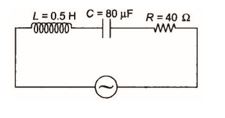
Ans. (d)
Q.4
In the series L–C–R circuit shown, the impedance is
(a) 200 Ω
(b) 100 Ω
(c) 300 Ω
(d) 500 Ω
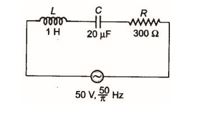
Ans. (d)
Q.5
The power factor of an R–L circuit is \displaystyle \frac{1}{{\sqrt{2}}}. If the frequency of AC is doubled, what will be the power factor ?
(a) \displaystyle \frac{1}{{\sqrt{3}}}
(b) \displaystyle \frac{1}{{\sqrt{5}}}
(c) \displaystyle \frac{1}{{\sqrt{7}}}
(d) \displaystyle \frac{1}{{\sqrt{{11}}}}
Ans. (b)
Q.6
In the circuit shown in figure neglecting source resistance, the voltmeter and ammeter readings will be respectively
(a) 0 V, 3 A (b) 150 V, 3 A (c) 150 V, 6 A (d) 0 V, 8 A
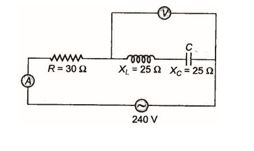
Ans. (d)
Q.7
The impedance of a circuit, when a resistance R and an inductor of inductance L are connected in series in an AC circuit of frequency f, is
(a) \displaystyle \sqrt{{R+2{{\pi }^{2}}{{f}^{2}}{{L}^{2}}}}
(b) \displaystyle \sqrt{{R+4{{\pi }^{2}}{{f}^{2}}{{L}^{2}}}}
(c) \displaystyle \sqrt{{{{R}^{2}}+4{{\pi }^{2}}{{f}^{2}}{{L}^{2}}}}
(d) \displaystyle \sqrt{{{{R}^{2}}+2{{\pi }^{2}}{{f}^{2}}{{L}^{2}}}}
Ans. (c)
Q.8
Voltage and current in an AC circuit are given by \displaystyle V=5\sin \left( {100\,\pi t-\frac{\pi }{6}} \right) and \displaystyle I=4\sin \left( {100\,\pi t+\frac{\pi }{6}} \right).
(a) voltage leads the current by 30º
(b) current leads the voltage by 30º
(c) current leads the voltage by 60º
(d) voltage leads the current by 60º
Ans. (c)
Q.9
An inductance of 1 mH, a condenser of 10 µF and a resistance of 50 Ω are connected in series. The reactances of inductor and condensers are same. The reactance of either of them will be
(a) 100 Ω (b) 30 Ω (c) 3.2 Ω (d) 10 Ω
Ans. (d)
Q.10
In L–C–R circuit, the capacitance is changed from C to 4C. For the same resonant frequency, the inductance should changed from L to
(a) 2 L (b) L / 2 (c) L / 4 (d) 4 L
Ans. (c)
Q.11
The resonant frequency of a circuit is f. If the capacitance is made 4 times the initial value, then the resonant frequency will become
(a) f / 2 (b) 2 f (c) f (d) f / 4
Ans. (a)
12.
In a series R-L-C circuit, R = 100 \displaystyle \Omega , XL = 300 \displaystyle \Omega and Xc = 200 \displaystyle \Omega . The phase angle \displaystyle \phi of the circuit is
(A) 00
(B) 900
(C) 450
(D) – 450
Ans (C)
13.
In a series LRC circuit, resonance occurs when
(A) R = XL ~ XC
(B) XL = XC
(C) XL = 10 XC more
(D) XL – XC> R
Ans (B)
14.
The power factor in AC circuit is equal to
(A) Z/R
(B) R/Z
(C) RZ
(D) none of the above
Ans (B)
15.
A series AC circuit has a resistance of 12 \displaystyle \Omega and reactance 5 \displaystyle \Omega . The impedance of circuit is
(A) 5 \displaystyle \Omega
(B) 12 \displaystyle \Omega
(C) 13 \displaystyle \Omega
(D) 17 \displaystyle \Omega
Ans (C)
16.
By what percentage the reactance in an AC circuit should be increased so that the power factor changes from (1/2) to (1/4)?
(a) 200%
(b) 100%
(c) 50%
(d) 400%
Ans (b)
17.
The angular frequency of a resonant LC combination (L = 10mH and C = 1 \displaystyle \mu F) is
(a) 1.0 × 104 radian per sec
(b) 1.0 × 104 Hz
(c) 1.0 × 10–4 radian per sec
(d) 1.0 × 10–4 Hz
Ans (a)
18.
An inductance coil of 1 Henry and a condenser of capacity 1pF produce resonance. The resonant frequency will be
(a) \frac{{{{{10}}^{6}}}}{{2\pi }}Hz
(b) \frac{{{{{10}}^{6}}}}{\pi }Hz
(c) \frac{{2\pi }}{{{{{10}}^{6}}}}Hz
(d) 2 \displaystyle \pi ´ 106 Hz
Ans (a)
Practice Questions (Level-2)
Q.1
In a series LCR circuit, the frequencies f1 and f2 at which the current amplitude falls to \frac{1}{{\sqrt{2}}} of the current at resonance, are separated by an interval equal to (R/2pL).
(a) \displaystyle \frac{{2R}}{{\pi L}}
(b) \displaystyle \frac{R}{{2\pi L}}
(c) \displaystyle \frac{{7R}}{{2\pi L}}
(d) \displaystyle \frac{R}{L}
Ans : (b)
Q.2
A circuit element is placed in a black box. At t = 0, switch is closed and the current flowing through the circuit element and the voltage across its terminals are recorded to have the wave shapes shown in the figure. The type of element and its magnitude are
(a) inductance of 4 H
(b) resistance of 4 W
(c) capacitance of 1 F
(d) a voltage source of emf 4 V

Ans. (c)
Q.3
The adjoining figure shows on A.C. circuit with resistance R, inductance L and source voltage Vs.

4.
In an a.c. circuit voltage v and current i are given by v = 100 sin 100 t volts,
i = 100 sin {100 t + \displaystyle \pi /3} mA. The power dissipated in the circuit is
(A) 104 W
(B) 10 W
(C) 2.5 W
(D) 5 W
Ans (D)
5.
In the a.c. circuit shown in the following figure, the resultant potential difference is
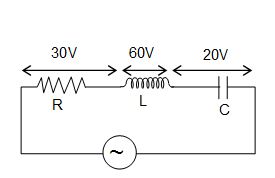
(A) 110 V
(B) 10 V
(C) 50 V
(D) 70 V
Ans (C)
6.
An alternating voltage E = E0 sin \displaystyle \omega t, is applied across a coil of inductor L. The current flowing through the circuit at any instant t is
(A) E0 / \displaystyle \omega L sin ( \displaystyle \omega t + \displaystyle \pi /2)
(B) E0 / \displaystyle \omega L sin ( \displaystyle \omega t – \displaystyle \pi /2)
(C) E0 \displaystyle \omega L sin ( \displaystyle \omega t – \displaystyle \pi /2)
(D) E0 \displaystyle \omega L sin ( \displaystyle \omega t + \displaystyle \pi /2)
Ans (B)
7.
In an R-L-C circuit v = 20 sin (314 t + 5 \displaystyle \pi /6) and i = 10 sin (314 t + 2 \displaystyle \pi /3) The power factor of the circuit is
(A) 0.5
(B) 0.966
(C) 0.866
(D) 1
Ans (C)
8.
The impedance of the circuit is
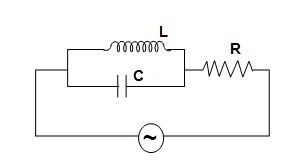
(A) \sqrt{{{{R}^{2}}+{{{\left( {\frac{{\omega L}}{{1-{{\omega }^{2}}LC}}} \right)}}^{2}}}}
(B) \sqrt{{\frac{1}{{{{R}^{2}}}}+{{{\left( {\frac{1}{{\omega L-1/\omega C}}} \right)}}^{2}}}}
(C) \sqrt{{{{R}^{2}}+{{{\left( {\omega L-\frac{1}{{1-\omega C}}} \right)}}^{2}}}}
(D) none of the above
Ans (A)
9.
In a series LCR circuit, the frequencies {{f}_{1}} and {{f}_{2}} at which the current amplitude falls to 1/\sqrt{2} of the current amplitude at resonance are separated by frequency interval
(a) \frac{R}{{2\pi L}}
(b) 2\pi \sqrt{{LC}}
(c) \sqrt{{LC}}
(d) RC
Ans (a)
10.
An alternating potential V={{V}_{0}}\sin \omega t is applied across a circuit. As a result, the current I={{I}_{0}}\sin \left( {\omega t-\frac{\pi }{2}} \right) flows in it. The power consumed in the circuit per cycle is
(a) zero
(b) 0.5 {{V}_{0}}{{I}_{0}}
(c) 0.707 {{V}_{0}}{{I}_{0}}
(d) 1.414 {{V}_{0}}{{I}_{0}}
Ans (a)
11.
What is the r.m.s. value of an alternating current which when passed through a resistor produce heat which is thrice that produced by a current of 2 ampere in the same resistor
(a)6.00A
(b) 2.00 A
(c)3.46A
(d) 0.65 A
Ans (c)
12.
An alternating voltage V = V0 sin \displaystyle \omega t is connected to a capacitor of capacity C0 through an AC ammeter of zero resistance. The reading of ammeter is
(a) \frac{{{{V}_{0}}\sqrt{2}}}{{\omega C}}
(b) \frac{{{{V}_{0}}}}{{\omega C\sqrt{2}}}
(c) \frac{{{{V}_{0}}\omega C}}{{\sqrt{2}}}
(d) none of these
Ans (c)
13.
Calculate the r.m.s. value of e.m.f. given by E=50\sqrt{2}\sin \left( {\omega t-\frac{\pi }{4}} \right)
(a) 50 V
(b) 5 V
(c) 2\sqrt{5}V
(d) None of these
Ans (a)
14.
An inductance coil of 1 Henry and a condenser of capacity 1pF produce resonance. The resonant frequency will be
(a) \frac{{{{{10}}^{6}}}}{{2\pi }}Hz
(b) \frac{{{{{10}}^{6}}}}{\pi }Hz
(c) \frac{{2\pi }}{{{{{10}}^{6}}}}Hz
(d) 2 \displaystyle \pi ´ 106 Hz
Ans (a)
15.
An alternating voltage V = V0 sin wt is applied across a circuit. As a result a current I = I0 sin ( \displaystyle \omega t – \displaystyle \pi /2) flows in it. The power consumed per cycle is
(a) zero
(b) 0.5 V0I0
(c) 0.707 V0I0
(d)1.414 V0I0
Ans (a)
16.
Using an AC voltmeter the potential difference in the electrical line in a house is read to be
234 volt. If the line frequency is known to be 50 cycles/second, the equation for the line voltage is
(a) V = 165 sin (100 pt)
(b) V = 331 sin (100 pt)
(c) V = 220 sin (100 pt)
(d) V = 440 sin (100 pt)
Ans (b)
